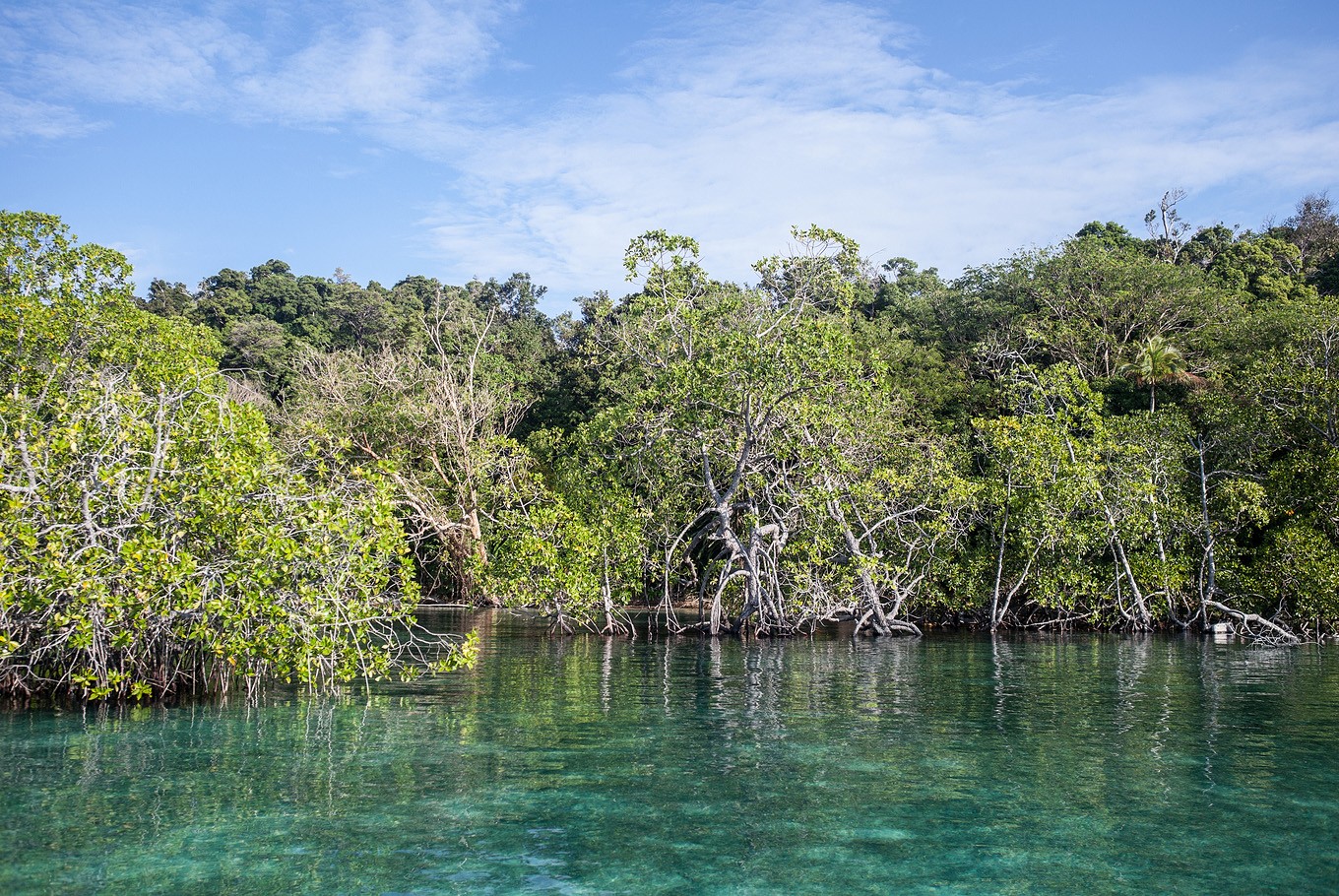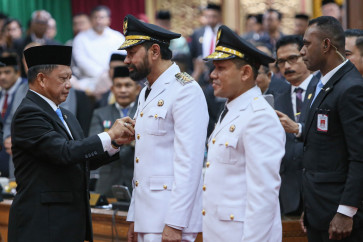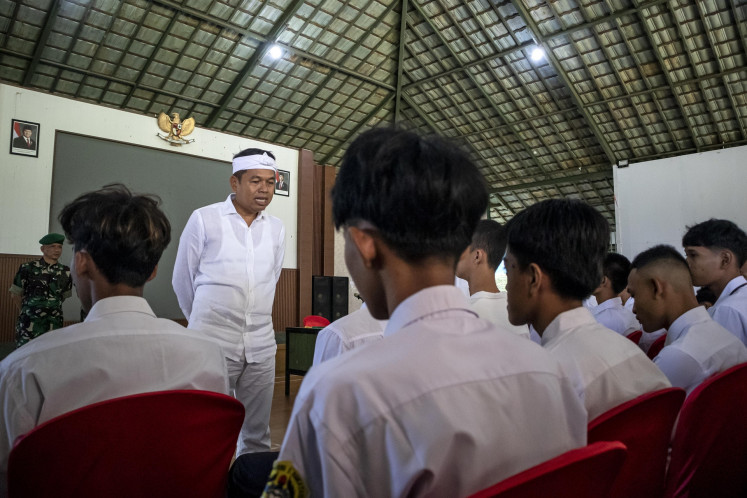The blue transformation toward Golden Indonesia 2045
Developing Indonesia's multibillion-dollar blue economy in an inclusive and sustainable manner will significantly contribute to both GNI and GDP growth toward achieving the Golden Indonesia 2045 vision.
Change text size
Gift Premium Articles
to Anyone

S
ince achieving independence on Aug. 17, 1945, Indonesia has been enjoying significant improvements in almost all aspects of human life, from food security to health, education and infrastructure to people’s prosperity.
Over that period, the country’s poverty rate has declined from 75 percent in 1950 to 60 percent in 1970 and then to 9.57 percent last year (Statistics Indonesia/BPS, 2022). However, after 78 years of independence, Indonesia remains an upper middle-income country with gross national income (GNI) per capita of US$4,580.
According to the World Bank (2022), the GNI per capita of upper middle-income countries range from $4,466 to $13,845.
It was therefore timely that President Joko “Jokowi” Widodo coined his admirable vision of Golden Indonesia 2045 on Aug. 16, 2019, during a House of Representatives plenary session.
Under the National Development Planning Agency’s 2025-2045 National Long-Term Development Plan (RPJN), which President Jokowi launched on June 15, 2023, the Golden Indonesia 2045 envisions Indonesia becoming a developed, prosperous, sovereign and sustainable archipelagic nation by its centenary. The country is to become the world’s fifth largest economy with gross domestic product (GDP) of around $7 trillion and GNI per capita of $30,300.
Indonesia has every reason to achieve the Golden Indonesia 2045 vision, thanks to its rich natural resources in both its land and seas. This means the country’s production capacity is indeed gigantic.
In the meantime, Indonesia is the fourth most populous country in the world with 278 million people and is set to experience a demographic dividend from 2020 to 2035, which will provide huge domestic market potential and a young, productive workforce.
Furthermore, in terms of geo-economics, the country is located at the heart of the global supply chain, between the continents of Asia and Australia and the Pacific and Indian oceans. Around 45 percent of total global commodities and products with an economic value of around $15 trillion per year is transported through Indonesia’s sea lanes (UNCTAD, 2016).
To achieve the Golden Indonesia vision, we have to generate high economic growth of more than 7 percent per year, which could provide a larger number of jobs in an inclusive, environmentally friendly and sustainable way. Such quality growth can be generated by increasing investment and production bases across the archipelago, particularly in the country’s eastern and less developed regions.
Imports of goods and services must be selective and strictly controlled to not only achieve a trade surplus, but also protect our national industries from unfair competition and uphold national sovereignty.
It is therefore high time for Indonesia to attain sovereignty in food, pharmaceutical products, minerals, energy and water to anticipate disruptions resulting from the triple ecological crises of pollution, biodiversity loss and climate change, increasing geopolitical tensions and rapid technological advancement.
Indonesia is endowed with rich coastal and marine resources that can be utilized to boost inclusive and sustainable economic growth. These natural resources can be transformed into real advancement and prosperity through 11 sectors of the blue economy: (1) capture fisheries, (2) aquaculture, (3) fish and seafood processing, (4) marine biotechnology, (5) energy and mineral resources, (6) coastal and marine tourism, (7) coastal forestry, (8) small island resources, (9) sea transportation, (10) maritime manufacturing and services, and (11) nonconventional resources (emerging sector).
The latter refers to untapped natural resources located in coastal and marine areas, such as ocean energy, hydrate gas, deep sea mining, deep sea fishing, offshore aquaculture and development of ocean space (floating city).
The estimated annual economic potential of these 11 sectors is $1.4 trillion per year, or 1.3 times the current GDP, with a potential to create 45 million jobs (PKSPL-IPB, 2014).
The gigantic potential can be illustrated by the shrimp aquaculture industry. The country has around 3 million hectares of coastal land suitable for shrimp aquaculture. If we develop just one-sixth of it for shrimp aquaculture with an average stocking density of 60 shrimps per square meter, we can produce 20 million tonnes of shrimp per year for a total revenue of $80 billion.
The industry can also generate 2 million direct (on-farm) jobs and 5 million off-farm jobs.
It is worth noting that there are many other highly important aquaculture species such grouper, barramundi, lobster, crab, abalone, sea cucumber, pearl oyster, seaweed, tilapia and giant freshwater prawn that can be farmed to generate profits, jobs and prosperity.
Another example is the marine biotechnology sector comprising: (1) extraction of bioactive compounds and other substances from marine organisms for a myriad of industries; (2) genetic engineering to produce top-quality brood stocks and seeds of both fauna (fish, animals) and flora (algae, food crops); and (3) genetic engineering of microbes to clean up environmental pollution.
South Korea’s Oceans and Fisheries Ministry has estimated the potential economic value of marine biotechnology industry at four times the size of the semiconductor industry.
Despite the huge potential, the utilization rate of the blue economy has reached only 30 percent and contributed only 15 percent to the country’s GDP. And sadly, the majority of fishers, fish farmers and other coastal communities continue to live in poverty.
Against this backdrop, we must implement the blue transformation through the use of state-of-the-art technology, including blockchain, big data, robotics, artificial intelligence, biotechnology and nanotechnology.
On the practical level, the blue transformation involves nine core policies.
First is revitalizing all businesses in blue economy sectors to increase their productivity, efficiency, competitiveness, inclusiveness and sustainability.
Second is expanding development, investment and businesses of blue economy sectors in new coastal and marine areas across the archipelago.
Third is the development of emerging blue economy sectors, particularly marine biotechnology, offshore aquaculture, bioenergy from marine algae, ocean energy (waves, tides, currents and ocean thermal energy conversion) and seawater desalination.
Fourth is revitalization and development of new maritime infrastructure, including ports, shipyards and dockyards, and digital connectivity.
Fifth are mitigation and adaptation measures for global warming, tsunami, earthquakes, floods and other natural hazards.
Sixth is strengthening and developing research and innovation to ensure the productivity, efficiency, competitiveness and sustainability of blue economy development.
Seventh is strengthening and developing human resources to provide a high quality workforce to run the blue transformation.
Eighth is strengthening and developing maritime diplomacy, security, and defense and culture.
Ninth and finally, all political and economic policies, including those on political stability, fiscal, monetary, bank loans, tax, trade, investment climate and ease of doing business, must be made conducive for the blue transformation.
***
The writer is a professor emeritus of sustainable development at Shinhan University, South Korea, a deputy chairman of maritime affairs and fisheries at the Indonesian Democratic Party of Struggle (PDI-P), and a former maritime affairs and fisheries minister.









